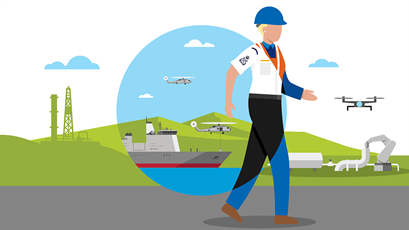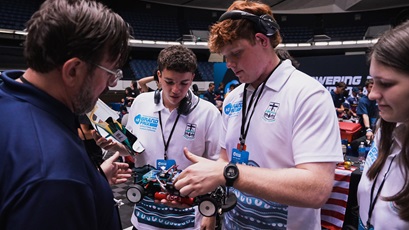people and community
restoring Colombia’s coral reefs
2 min read | november 20, 2024
The waters off the coast of Colombia are home to hundreds of thousands of acres of endangered coral reefs. A team of Chevron volunteers is working with local organizations to help restore and protect these reefs. Photo courtesy of the Blue Indigo Foundation.
Colombia is known for its fragrant coffee and beautiful landscapes, but there is a hidden treasure off the coast.
Under the country’s busy shipping lanes and cruise routes lie more than 440,000 acres of endangered coral reef. In 2021, Colombia began a reef restoration program to save this important natural habitat for corals—colonial organisms composed of hundreds to hundreds of thousands of individual animals called polyps.
The reefs targeted for restoration include those at Isla Fuerte, Providencia, Santa Marta, Rincón del Mar and Varadero.
Alejandro Riveros, Chevron’s corporate affairs advisor for Colombia and Central America, and a team of Chevron volunteers saw a chance to help. They collaborated with Corales de Paz, a science-based reef protection group. Together, they started the Energy Reefs program.
“Community involvement is so important to the protection of these ecosystems. We have the third-largest reef formation in the world,” said Riveros.
The project started with a single growing tank for coral. It soon expanded to include coral reef monitoring and school programs to help restore the coral forest.

Chevron volunteers including Alejandro Riveros joined in local dives to monitor the growth of new coral. Photo courtesy of the Blue Indigo Foundation.
1 million corals
In 2022, UNESCO reported that nearly 80% of the Caribbean reef had been lost because of coastal development and other factors.
As Energy Reefs came together, so did the largest coral reef rebuilding plan in the Americas. One Million Corals for Colombia aimed to restore more than 494 acres of reef. To get there, they needed to grow one million coral pieces.
It was a big task—494 acres is nearly the size of 374 football fields.
To help tackle the challenge, the Energy Reefs team gathered community members, experts, journalists and local leaders. Chevron volunteers also joined dives to measure the reef’s condition.
While at sea, these citizen scientists learned how to recognize coral bleaching—damage caused by rising sea temperatures.
juliana rodríguez
communication manager
corales de paz
benefits beyond the sea
In June 2023, the Colombian Ministry of Environment and Sustainable Development reported that, at that time, thanks to the One Million Corals for Colombia project, 735,822 new fragments of more than 30 coral species had been obtained in 12 coral areas of the Caribbean and Colombian Pacific.
Energy Reefs volunteers observed approximately 17,000 feet of reef during the sponsored dives. By monitoring the condition of the coral, they could identify areas that needed extra help. The program also supported the local community by:
- Educating more than 1,000 children about marine protection through school visits sponsored by Energy Reefs.
- Creating nearly 120 jobs.
- Establishing a coral growing station that became a genetic bank to save Caribbean coral.
In October 2023, the project earned four recognitions for its work:
- Best Project for Biodiversity from the British Embassy in Colombia
- Best Project for Water Care from the British Embassy in Colombia
- Hechos de Sostenibilidad Award (Alliances for Sustainability Development category) from World Social Marketing
- Recognition as a Successful Case (Climate Change and Sustainability category) from World Social Marketing
topics covered
related content
-
chevron announces 2025 capex budget & 4Q24 interim updates
people and communitydecember 05, 2024
-

 fashion event shows that inclusivity is always in style
fashion event shows that inclusivity is always in stylepeople and communitynovember 18, 2024
-

 from service to sector: veterans power up their future in energy
from service to sector: veterans power up their future in energypeople and communitynovember 08, 2024
-

 in race car competition, hydrogen is an element of success
in race car competition, hydrogen is an element of successpeople and communitynovember 05, 2024
chevron email updates
Subscribe to our newsletter to receive news and updates.



